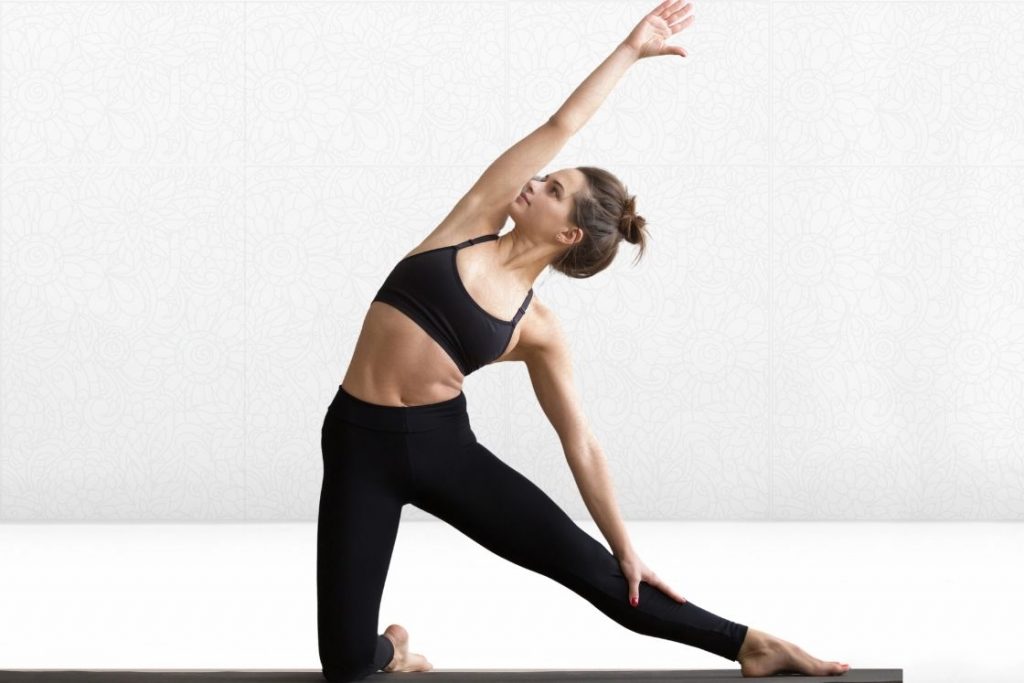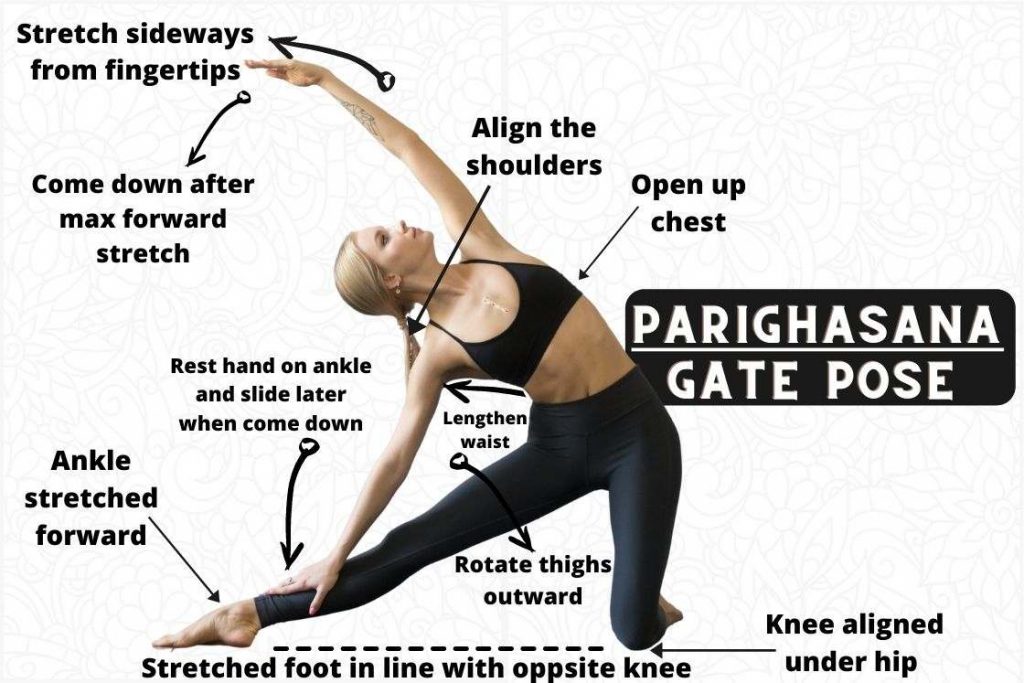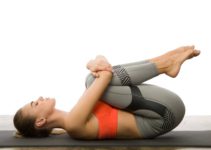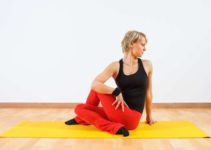
Parighasana is a kneeling side bending pose of Hatha Yoga. It gives a deep lateral stretch to the sides of the body; along with active stretch to legs, hips, and core muscles.
It has given the name Gate pose in yoga as it’s a gateway for those parts of the body which need much supply of oxygen but due to lifestyle and physical inactivity, it has been obstructed.
Meaning
In Sanskrit, ‘Parigha’ means ‘the bar used to close the gate’ and ‘asana’ means ‘pose’. In this asana, when we stretch sideways with both hands parallel to each other, the stretched body and the hands look similar to the lateral bars of a gate. Hence, Parighasana is transliterated as Gate pose yoga.
In yoga, forward and backward bending or twisting have their influence in most of the poses.
You will see when performing Parighasana there creates a space between upper and lower stretched hands. This space gives extra room to intercostal muscles to expand that connect our ribs and remove stiffness.
Psychologically, the practice of gate pose yoga gives away the unnecessary thoughts that might cause an interruption to the relaxing mind.
Parighasana was unknown before the 20th century; but according to Mark Singleton, author of Yoga Body, this pose resembles the one from modern gymnastic.
However, it is not clarified that Krishnamacharya, father of modern yoga, derived this asana from gymnastics at that time.
Parighasana Practice Guide
Go through the following points before performing the Parighasana (gate pose).
Precautions & Contraindications
- In case of knee or ankle injury go slowly in this asana under guidance or perform it while sitting on a chair.
- Practitioners with the condition of lower back pain and cervical might refrain from practicing this asana; as it could worsen the previous situation.
Preparatory Pose
- Bound Angle pose (Baddha Konasana)
- Virasana (Hero Pose)
- Downward-facing Dog Pose (Adho Mukha Svanasana)
How to Do Parighasana (Steps)

- Begin by coming into the kneeling position; your hand beside the hips and trunk upright. Breath gently!
- Stretch your right leg in the right direction. Your ankle should be in line with the left knee and torso. Straighten your right knee to grip your left foot firmly on the floor.
- Now, inhale and stretch your arms sideways on either side of the trunk.
- Exhale and move your trunk right side, towards the stretched right leg. Your right forearm and wrist should rest on the shinbone and ankle, respectively.
- Your right palm faces upside. Now, take your left palm over the head and place it on the right palm. Make Namaste with your hands on ankle if possible, here your right ear will touch the upper left palm.
- This is the final position of Gate pose, maintain the position here. Remain in the posture for a minimum of 30 to 50 seconds. Max can be performed as per one’s comfort level.
On completion one side, do in this same manner on the left side for an equal period of time. Then, inhale and come back in sideways hand position, bring the right leg back to the kneeling position, and do follow up poses.
Beginners Tips
- A beginner might find it difficult, Stiffened hamstring could restrict stretching of the leg in sideways. In this case, first, warm up your tight hamstring:
- Bend trunk forward in step 1, rest hands on the floor, and slide your leg slowly – from the center to outward and then back.
- Do not overstrain your trunk in bending if your hands are not reaching to the ankles. Place hands wherever it’s reaching on the legs. You will develop your side bending by regular practice.
Props and Modifications
- A block can be considered for beginners who are unable to reach their ankles.
- Place a block next to the stretched leg and later adjust it according to wherever your hands are able to reach.
- knees might hurt when practicing Parighasana for longer periods or in beginning.
- In this case, use a folded blanket underneath the knees and ankles to insulate it from the pain.
- In case of losing balance again and again one can take wall support by adjusting the balls of the foot on it.
Follow Up Pose
- Extended Side Angle Pose (Utthita Parsvakonasana)
- Triangle Pose (Trikonasana)
- Revolved Head-to-Knee Pose (Parivrtta Janu Sirsasana)
Variations
Gate pose comes with many variation in which base can be modified in the following ways:
1. Parivrtta Parighasana – Revolving Gate Pose
In this variation of gate pose, trunk is revolved back instead of stretching in the forward direction like base pose.
To do Parivrtta Parighasana,
- From second step Parighasana, bend backward and place the right hand next to the right ankle.
- Extend the left leg out in the same way,
- Stretch left arm over the head and arch back spine further. Support body on the right leg and right arm.
- Repeat the same on the left side.
2. Side plank in Gate Pose
In this variation, the body is stretched in the same way as in side plank. To do this,
- From kneeling position, lean to the left side, place your left palm on the floor or a block, and right arm straight upside in the air.
- Now, while maintaining the balance; initiate a twist from the thoracic spine to the right side. Bend your elbow and place the hand behind the head and allow a little support to the head; giving relief to the neck muscles.
- Set a gaze to the ceiling side and hold the posture for few breaths; then release and relax.
3. Elbow to knee stretch in Gate Pose
In this variation, from side plank position of gate pose, extended arm and leg are stretched and contracted with breath inhale and exhale respectively.
- From kneeling, lean to the left side and place your left hand on the floor. Your right arm and right leg should be stretched out.
- Now with an exhalation, bend your right leg and right arm to touch it on the hips level.
- Then with inhalation, straighten the bend arm and leg to come into the initial position.
Parighasana (Gate Pose) Benefits
- Promote deep breathing – The sideways bending stretches the intercostal muscles. It enhances chest mobility and aid in efficient respiration. This way Parighasana promotes good breathing habits in asthma and COPD patients.
- Restores health of abdominal organs – One by one sideways bending to the left and right side massages the abdominal organs; like liver, kidneys, stomach, intestines, spleen, and pancreas. In this way, Parighasana harmonizes the digestive system and enhances the functioning of abdominal organs by exchanging deoxygenated blood from the oxygenated blood.
- Overcomes obesity – It sets muscles into intense stress while bending either side; this raises the activity at the cellular level to suffice the demand for energy (more calories burn). Therefore, regular practice of gate pose results in the utilization of extra fat from the various parts of the body.
- Improve flexibility – It gives a deep stretch to the calves, hamstring, quadriceps, biceps, triceps, abdominal, hip-flexors, gluteus, etc. The back to back contraction and relaxation of the muscles loosen up the muscle fibers; Hence, makes the body flexible.
- Helps in pranayama (yogic breathing) – Stretching of intercostal muscles in this pose enhances the thoracic volume and strengthen the chest muscles. Such transformation to the thoracic cavity ensures freedom of movement for the lungs, which is of utmost importance for Pranayama practice.
- Mobilizes pelvic joint – Holding a Stretched leg to the sideways in Parighasana allow pelvic muscles and joint to open up, which can be enhanced by increase the time period of holding; Therefore, improve movements.
- Activates Ajna Chakra – Consistent practice of this asana results in the activation of Ajna chakra. It is considered as the head of the rest of the chakras; activation of this chakra blessed a practitioner with the energized body; However, it is also beneficial for eyes and nose.




